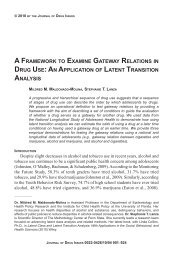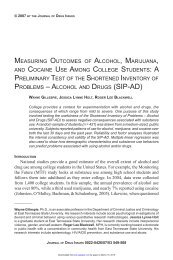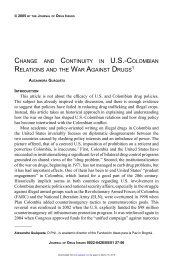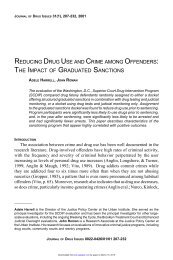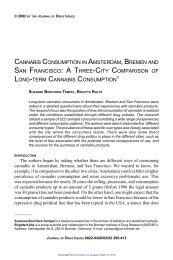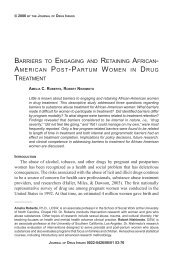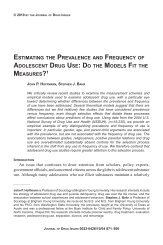a brief history of cannabis policies in spain - Journal of Drug Issues
a brief history of cannabis policies in spain - Journal of Drug Issues
a brief history of cannabis policies in spain - Journal of Drug Issues
You also want an ePaper? Increase the reach of your titles
YUMPU automatically turns print PDFs into web optimized ePapers that Google loves.
GAMELLA, JIMÉNEZ RODRIGO<br />
users jabb<strong>in</strong>g their ve<strong>in</strong>s <strong>in</strong> close proximity to founta<strong>in</strong>s or sources <strong>of</strong> water <strong>in</strong><br />
parks, streets, or roads. It was also common to see emaciated addicts driv<strong>in</strong>g or<br />
walk<strong>in</strong>g to their suppliers <strong>of</strong> coca<strong>in</strong>e or hero<strong>in</strong>. The most visible outlets for hero<strong>in</strong><br />
and coca<strong>in</strong>e, serv<strong>in</strong>g mostly deteriorated hero<strong>in</strong> addicts, had consolidated <strong>in</strong> slums<br />
and broken neighborhoods on the outskirts <strong>of</strong> cities; many <strong>of</strong> these were occupied<br />
then by Gitanos – Spanish Gypsies. The new drug trade became a source <strong>of</strong><br />
renovated prejudice and discrim<strong>in</strong>ation aga<strong>in</strong>st this m<strong>in</strong>ority (see Gamella, 2002).<br />
These public behaviors provoked much alarm and were used to criticize the<br />
government. In October 1989, the socialist party had won its third absolute majority<br />
<strong>in</strong> national elections (follow<strong>in</strong>g another victory <strong>in</strong> 1986), but many <strong>of</strong> its liberaliz<strong>in</strong>g<br />
and privatiz<strong>in</strong>g <strong>policies</strong> were contested by trade unions. A general strike had<br />
paralyzed the country some months before; corruption scandals began to accumulate,<br />
and the traditional power base <strong>of</strong> the socialists was eroded.<br />
The harden<strong>in</strong>g <strong>of</strong> national drug regulations seemed to co<strong>in</strong>cide with popular<br />
demands. In 1991, a social movement aga<strong>in</strong>st drug dealers and junkies swept through<br />
Madrid, Valencia, and other major cities. Demonstrations, protests, riots, and longterm<br />
collective occupation <strong>of</strong> places to avoid the establishment <strong>of</strong> Gypsy tenements<br />
were important news <strong>in</strong> the fall <strong>of</strong> 1991. The movement had a populist character<br />
and <strong>of</strong>ten fostered prejudiced and even racist overtones. The media devoted much<br />
space and time to the vigilante patrols that harassed emaciated hero<strong>in</strong> addicts near<br />
the ramshackle tenements where drugs were dealt (López Varas & Fresnillo, 1996;<br />
Gamella, 2002).<br />
Amaz<strong>in</strong>gly, both the socialist and the conservative (“popular”) governments<br />
that followed them <strong>in</strong> 1996 have actively enforced the articles <strong>of</strong> the law (Article<br />
25, among others) concern<strong>in</strong>g drug consumption and possession <strong>in</strong> public sett<strong>in</strong>gs.<br />
Peculiarly, this part <strong>of</strong> the law has been applied more to occasional users than to<br />
addicts, and especially to those who prefer <strong>cannabis</strong>, the most common consumers<br />
<strong>of</strong> illegal drugs (OED, 2000, pp. 71-72; OED, 2003, pp. 137-38).<br />
THE REDUCTION OF THE HEROIN CRISIS AND THE AIDS EPIDEMIC<br />
Throughout the 1990s, harm-reduction measures and programs were <strong>in</strong>creas<strong>in</strong>gly<br />
accepted and expanded. Thus, after some trials from 1988 to 1991, needle-exchange<br />
programs became common <strong>in</strong> all regions. Pharmacies also became actively <strong>in</strong>volved<br />
<strong>in</strong> the harm-reduction efforts. After a drastic change <strong>of</strong> regulations <strong>in</strong> 1990,<br />
methadone provision was extended, especially after 1994. By 2000, there were<br />
80,000 people on subsidized methadone programs all over Spa<strong>in</strong> (OED, 2001).<br />
Resistance to these harm reduction <strong>in</strong>itiatives abated. Needle-exchange programs<br />
<strong>in</strong> jails, however, are still forbidden <strong>in</strong> some regions. Also, there have been conflicts<br />
between regional and local governments concern<strong>in</strong>g some <strong>in</strong>novative programs,<br />
636 JOURNAL OF DRUG ISSUES<br />
Downloaded from jod.sagepub.com by guest on March 15, 2015








